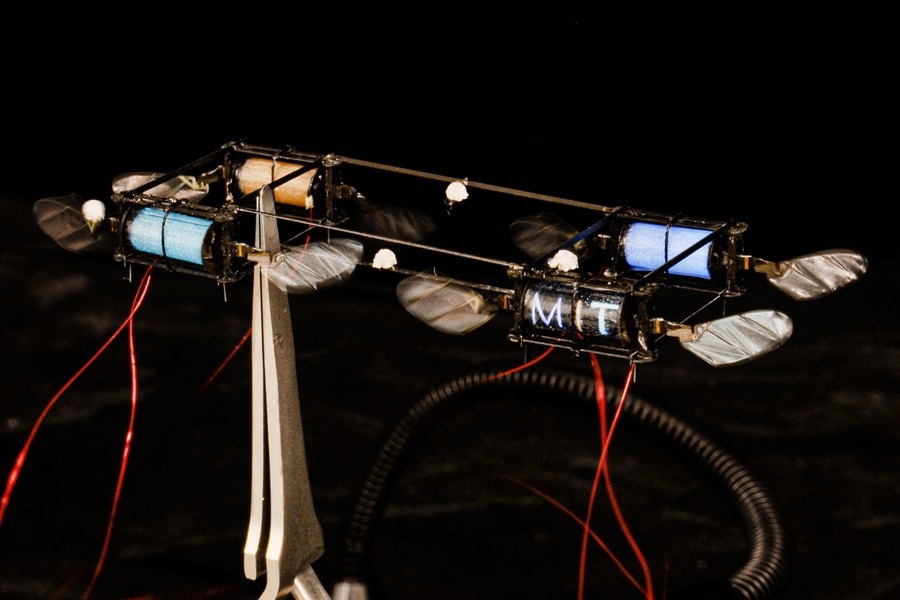Researchers at MIT working on insect-scale robots, or microbots, have drawn inspiration from nature by developing a flying microbot that emits light as it flies, much like a firefly. This innovative approach to robotics could help facilitate easy motion tracking and boost the communication capacity of the microbots.

Image Credit: MIT
Powered by soft artificial muscles fabricated from electroluminescent dielectric elastomer actuators, the tiny robots are agile and could have the potential to fly in swarms. A detailed overview of the research was recently published in the journal IEEE Robotics and Automation Letters.
The light-emitting wings mean that these robots have the potential to communicate with one another. For example, if sent on a search and rescue mission in a hazardous zone, the swarm could spread out across a wide area, and if survivors are located, one robot could signal to the rest of the swarm and use its electroluminescence to call for help.
If you think of large-scale robots, they can communicate using a lot of different tools – Bluetooth, wireless, all those sorts of things. But for a tiny, power-constrained robot, we are forced to think about new modes of communication. This is a major step toward flying these robots in outdoor environments where we don’t have a well-tuned, state-of-the-art motion tracking system.
Kevin Chen, Assistant Professor in the Department of Electrical Engineering and Computer Science (EECS) and The Head of the Soft and Micro Robotics Laboratory in the Research Laboratory of Electronics (RLE)
Another unique feature of the insect-scale robots is that they are around the same weight as a paperclip as the artificial muscles have embedded electroluminescent particles. This only adds around 2.5% weight onto the flying microbot and has no bearing on its flight performance or agility.
With this lightweight advancing technology and its light-emitting wings, insect-like robots could soon be deployed outside the lab. Typically, to track these devices, awkward and cumbersome infrared (IR) cameras that are not good for outdoor operations are normally required. Yet, this innovative approach means the electroluminescent robots can be tracked with just three smartphone cameras and an app.
To successfully fabricate the light-emitting actuators, the team had to overcome a series of challenges as the electroluminescent zinc sulfate particles would only glow when a strong, high-frequency electrical field was supplied.
The researchers applied high voltages to generate an electric field in the soft actuator, which was strong enough to power the robot at a high frequency; this allowed the particles to emit a bright glow.
The researchers also had to construct a transparent electrode so that light could easily pass through the actuators; this was achieved using carbon nanotubes that allowed the light to permeate the wings.
Traditionally, electroluminescent materials are very energetically costly, but in a sense, we get that electroluminescence for free because we just use the electric field at the frequency we need for flying. We don’t need new actuation, new wires, or anything. It only takes about 3 percent more energy to shine out light.
Kevin Chen, Assistant Professor in the Department of Electrical Engineering and Computer Science (EECS) and The Head of the Soft and Micro Robotics Laboratory in the Research Laboratory of Electronics (RLE)
However, the team was struck by how easily the actuators would break down during the prototyping phases as a result of the zinc particles. EECS graduate student Suhan Kim worked around this issue by only applying the zinc particles to the top elastomer layer only. Kim then made that layer a few micrometers thicker to offset for power reduction.
We put a lot of care into maintaining the quality of the elastomer layers between the electrodes. Adding these particles was almost like adding dust to our elastomer layer. It took many different approaches and a lot of testing, but we came up with a way to ensure the quality of the actuator.
Suhan Kim, EECS Graduate Student
The researchers also found that the light would change color depending on the chemical makeup of the zinc particles. This enabled them to produce actuators of different solid colors, and by adjusting the fabrication method, they could also produce multicolored light displays – even spelling out MIT in light with the robots.
The tracking system that uses smartphone cameras was also demonstrated to be highly effective as it was able to track the microbots within 2mm of the most sophisticated IR camera systems.
We are very proud of how good the tracking result is, compared to the state-of-the-art. We were using cheap hardware, compared to the tens of thousands of dollars these large motion-tracking systems cost, and the tracking results were very close.
Kevin Chen, Assistant Professor in the Department of Electrical Engineering and Computer Science (EECS) and The Head of the Soft and Micro Robotics Laboratory in the Research Laboratory of Electronics (RLE)
Robotic lightning bugs
Video Credit: MIT
The next phase is to improve the motion tracking system even more so that the insect-scale robots can be tracked in real-time scenarios outside the lab and communicate the way fireflies do in nature. In fact, the team believes that taking the robots outside the lab could demonstrate just how effective this technology could be in real-world applications, which would signal a significant breakthrough for Chen and his team.
References and Further Reading
Kim, S., Hsiao, Y., Chen, Y., Mao, J. and Chen, Y., (2022) FireFly: An Insect-Scale Aerial Robot Powered by Electroluminescent Soft Artificial Muscles. IEEE Robotics and Automation Letters, [online] 7(3), pp.6950-6957. Available at: https://ieeexplore.ieee.org/document/9786652
Zewe, A., (2022) Robotic lightning bugs take flight. [online] MIT News | Massachusetts Institute of Technology. Available at: https://news.mit.edu/2022/robotic-actuator-fly-0621
Disclaimer: The views expressed here are those of the author expressed in their private capacity and do not necessarily represent the views of AZoM.com Limited T/A AZoNetwork the owner and operator of this website. This disclaimer forms part of the Terms and conditions of use of this website.